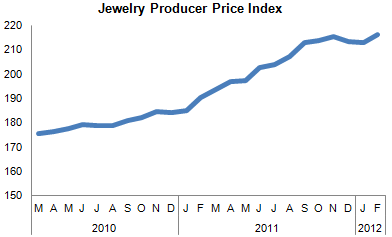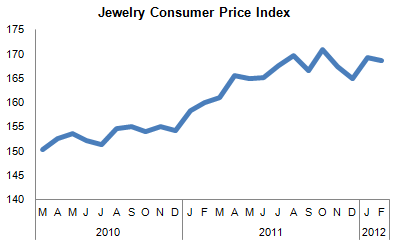IDEX Online Research: U.S. Jewelry Price Inflation Slows in February
March 19, 12
(IDEX Online) – Jewelry price inflation in the U.S. market showed signs of moderating in February. While commodity prices generally rose – average gold prices were up 5 percent in February versus January – these sharp increases were not fully passed through to jewelry producers’ prices.
The full analysis and statistics on jewelry industry inflation for February 2012 is available to IDEX Online Research subscribers and IDEX Online members here.
Further, retail jewelry prices in February were only slightly below January levels. Retail jewelry prices have been bouncing up and down for several months, so February’s lack of inflation was a welcome respite from prior months.
While inflation may have moderated in the jewelry distribution channel, the chasm between jewelry retail prices and jewelry supplier and producer prices remained wide. Essentially, jewelry wholesale prices are rising faster than jewelry retail prices; this results in a margin squeeze among retail merchants.
Jewelry Wholesale Price Inflation Moderates
In February, the Jewelry Producer Price Index (JPPI) stood at 216.2 versus January’s 213.0; a year ago, the JPPI stood at 190.4. Here’s what this means:
· Wholesale jewelry prices rose by about 1.5 percent on a month-to-month comparison basis: February versus January 2012.
· Wholesale jewelry prices rose by about 13.6 percent on a year-to-year comparison basis: February 2012 versus February 2011. This is down from January’s 15.0 percent inflation rate.
· The graph below summarizes the JPPI over the past two years.
 Source: BLS |
Jewelry Retail Price Inflation Slips Slightly
In February, the Jewelry Consumer Price Index (JCPI) stood at 168.6 versus January’s 169.3; a year ago, the JCPI stood at 160.0. Here’s what this means:
· Retail prices of jewelry fell by about 0.4 percent on a month-to-month comparison basis: February versus January 2012.
· Retail jewelry prices rose by about 5.3 percent on a year-to-year comparison basis: February 2012 versus February 2011. In January, retail jewelry prices rose by 6.8 percent.
· The graph below summarizes the JCPI over the past two years:
 Source: BLS |
February Jewelry Price Inflation Remains High
While the February JPPI (wholesale) inflation rate was under 14 percent, somewhat lower than prior months, it is still very high compared to historic levels in the low-to-mid single digit range.
Further, the February JCPI (retail) inflation rate of just over five percent, while more moderate than some months in 2011, is also running ahead of its historic low-to-mid single digit level.
The disparity between supplier price inflation and retail price inflation that characterized 2011 has continued into 2012, though at a slightly lesser rate. Here’s how this disparity in inflation rates between producers and retailers affects the American jewelry industry: the margin squeeze that specialty retail jewelers have felt since 2009 continues to manifest itself.
After being somewhat stable in late 2011, commodity prices – gold, silver, platinum – have moved higher in price. Precious metals prices correlate somewhat to the global economic climate since they are used in a wide variety of manufacturing processes. Further, geopolitical uncertainties cause investors to seek the historical safe haven of gold.
According to the latest forecasts from the OECD, the economies of most of the diamond-consuming countries are expected to grow modestly in 2012, though recent signs suggest a potentially more positive growth rate. This could lead to further disparity between retail jewelry prices and supplier prices.
When the global economy strengthens, precious metals prices will likely rise as demand solidifies. This will intensify the current margin squeeze that retailers are experiencing, unless retailers are able to pass along higher product costs.
The table below provides a summary of inflation rates in the U.S. jewelry industry for the following: 1) year-to-year price comparison for the month of February; 2) month-to-month price comparison for February versus January; and 3) two months of 2012 price comparisons versus the same two-month period in 2011.
 Source: Various markets |
Jewelry Inflation Outlook: Uncertainty Near Term, Higher Long Term
Our outlook for jewelry price inflation remains unchanged: jewelry prices are expected to move higher at all levels of the distribution channel throughout 2012 and perhaps beyond.
It would be easy to forecast inflation for the jewelry industry if all of the commodities involved in the forecast were used exclusively by the jewelry industry. While that may be the case for polished diamonds, precious metals are used by a number of other industries. Further, gold is an international currency that plays in a financial arena of its own.
· Jewelry Industry Long Term Outlook – Demand from emerging economies such as India and China will help fuel sales of jewelry in those nations. Thus, the longer-term outlook for jewelry demand is very positive.
· Global Economic Outlook for 2012 – The latest OECD data points to moderate economic growth with a “positive” outlook for stronger growth in the next 12-18 months.
· Financial Markets Outlook for 2012 – With continued volatility in the world’s stock markets and uncertain valuations related to stocks, bonds, and other hard assets, investors are likely to move to the safe haven that gold offers.
The bottom line: inflation is headed higher over the longer term. Jewelry suppliers and retailers should use periods of weakness in commodity prices to add to their inventory.
The full analysis and statistics on jewelry industry inflation for February 2012 is available to IDEX Online Research subscribers and IDEX Online members here. Click here for more information on how to subscribe or become a member.